FGS Conference Early-Bird Registration Ends July 1
June 10, 2013 – Austin, TX. Discounted early-bird registration for the 2013 Federation of Genealogical Societies Conference will continue only until July 1. Early registrants receive a $50 discount for the full four days, or a $20 discount for any single day. Details at http://www.fgsconference.
The conference will be held 21-24 August 2013 in Fort Wayne, Indiana at the Grand Wayne Convention Center. This year’s conference theme is “Journey through Generations,” and the local hosts are the Allen County Public Library (ACPL) and the Allen County Genealogical Society of Indiana (ACGSI). Platinum sponsors are FamilySearch, FindMyPast.com and Ancestry.com.
The conference offers opportunities for all who are interested in researching their family history, with over 160 educational sessions on records, strategies, and tools for genealogists at all levels. The exhibit hall features over 70 vendors offering a wide range of genealogical products and is open and free to the public.
Luncheons, workshops and special events provide additional opportunities for networking and learning. Make sure the get your tickets to these conference “extras” early to guarantee your spot.
See you in Fort Wayne in August!
Learn More and Stay Connected
- Visit or subscribe to the FGS Conference Blog at http://www.
fgsconferenceblog.org. - Like the conference on Facebook at http://www.facebook.com/
FGSconference. - Follow the conference on Twitter at http://www.twitter.com/
FGSconference and hashtag #FGS2013. - Visit Fort Wayne at http://www.visitfortwayne.
com/FGS.
Millions of global records now at FamilySearch.org
Millions of records from around the world are new at FamilySearch this week, and are completely free! These new collections include Australia, Denmark, Finland, France, Italy, and South Africa. PERSI also got a big update this week at Findmypast, as well as new and updated records for Canada, England, and Ireland.
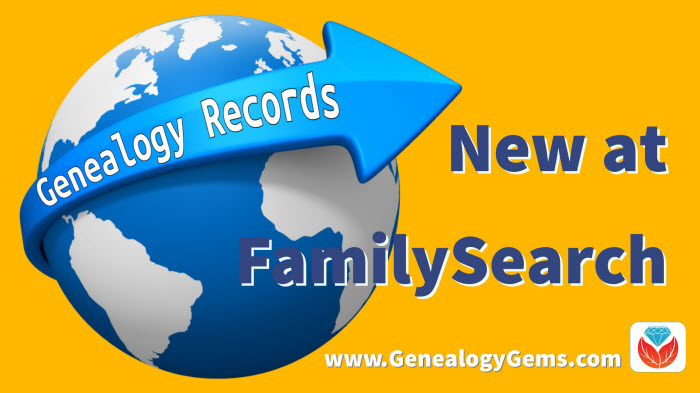
New collections free at FamilySearch
Australia. The new South Australia, Immigrants Ship Papers, 1849-1940 collection includes immigrants’ ships papers, containing a record of births and deaths aboard, 1849-1867 and 1873-1885. Indexed records in this collection include passenger lists arriving and departing from South Australia. (Original records in the State Records of South Australia, Adelaide.) Get started with Australian genealogy research with these tips from an expert at Legacy Tree Genealogists!
Denmark. FamilySearch has been adding census records for Denmark recently, and the latest new collection is the 1921 Denmark Census. This collection includes over 430,000 images, and these census collections were all provided by MyHeritage and previously from the National Archives of Denmark.
Finland. Church Census and Pre-Confirmation Books, 1657-1915: This collection contains church census books and pre-confirmation books kept by the Lutheran Church in Finland. These records come from a database at MyHeritage, citing Kansallisarkisto (National Archives of Finland), Helsinki.
France. Explore over half a million indexed records for Saône-et-Loire, Census, 1856, a complete indexing of the population censuses.
Italy. The Salerno, Civil Registration (State Archive), 1806-1949 collection includes civil registration (stato civile) records of births, marriages, and deaths within the custody of the State Archive of Salerno (Archivio di Stato di Salerno). Almost 6 million images are in this collection, and availability of records is largely dependent on time period and locality.
South Africa. Lastly, this collection of Pietermaritzburg Estate Files 1846-1950 is also new at FamilySearch. Records include death notices, vital records, wills, distribution accounts, and succession duty accounts.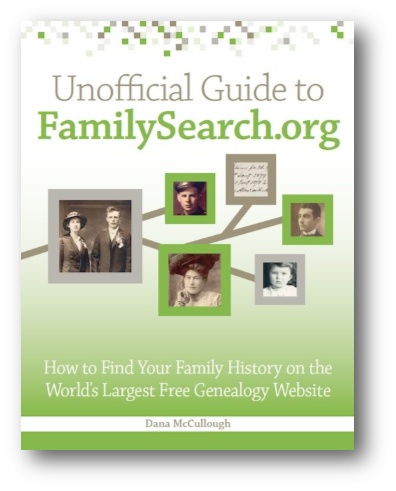
Need help using FamilySearch? The Unofficial Guide to FamilySearch.org by Dana McCullough provides the guidance you need to discover your ancestors and make the most of the free site’s valuable resources. Learn how to maximize all of FamilySearch.org’s research tools–including hard-to-find features–to extend your family tree in America and the old country.
PERSI update at Findmypast
The Periodical Source Index (also known as PERSI) has had another large update at Findmypast. Almost 11,000 new articles and 30,000 new images have been added, covering Pennsylvania, Wyoming, Toronto, and Yorkshire. PERSI is an excellent resource for discovering articles, photos, and other material you probably won’t find using conventional online search methods.
Click here to learn more about PERSI for genealogy research. Genealogy Gems Premium Members can also check out Premium Podcast episode #135 for more tips on PERSI (sign-in required). Not a Premium Member? Click here to get started!
Canada – New & Updated Collections
From Libraries and Archives Canada: Digitization of the Canadian Expeditionary Force Personnel Service Files. “As of today, 502,740 of the 640,000 files are available online in our Personnel Records of the First World War database…Library and Archives Canada is digitizing the service files systematically, from box 1 to box 10686, which roughly corresponds to alphabetical order.”
Ancestry.com updated two of their collections for Canada this week: Ontario, The Ottawa Journal (Birth, Marriage, and Death Notices) 1885-1980 and the Canada Obituary Collection, 1898-2017. Both of these collections come from microfilmed copies of the newspapers.
England Registrations
Recently announced on Twitter: “The General Register Office for England and Wales (GRO) is piloting a service from 12 October 2017 to provide portable document format (PDF) copies of digitized historical birth and death records. The pilot will run for a minimum of 3 months to enable GRO to assess the demand for this service over a prolonged period.” England and Wales records which are available as PDFs in this extended pilot include births (1837 –1916) and deaths (1837 –1957).
Ireland: Historical Newspaper
A new historical newspaper title was added to the British Newspaper Archive this week for Northern Ireland. The Coleraine Chronicle 1844-1910 was published by Alpha Newspaper Group in Coleraine, Londonderry, Northern Ireland. The collection features nearly 3,500 issues and over 26,000 pages.
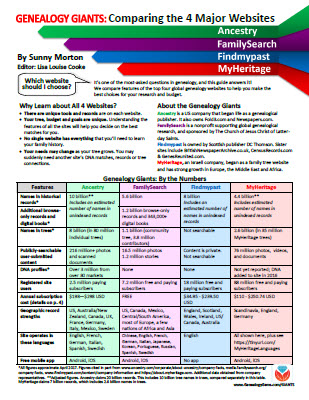 Get the most out of your genealogy records websites subscriptions!
Get the most out of your genealogy records websites subscriptions!
Use the jammed-packed Genealogy Giants cheat sheet by Sunny Morton to quickly and easily compare all of the most important features of the four biggest international genealogy records membership websites: Ancestry.com, FamilySearch.org, Findmypast.com, and MyHeritage.com. Then consult it every time your research budget, needs or goals change. Tables, bulleted lists, and graphics make this guide as easy to use as it is informative. Available in print or digital download.
Disclosure: This post contains affiliate links and Genealogy Gems will be compensated if you make a purchase after clicking on these links (at no additional cost to you). Thank you for supporting the free Genealogy Gems podcast and blog!
Surname Research for Free: Guild of One-Name Studies at FamilySearch.org
Sometimes you find yourself sorting through tons of people with the same last name to see which ones belong on your family tree. This surname research collection at FamilySearch can help you see what other researchers may have spent years compiling about thousands of family groups.
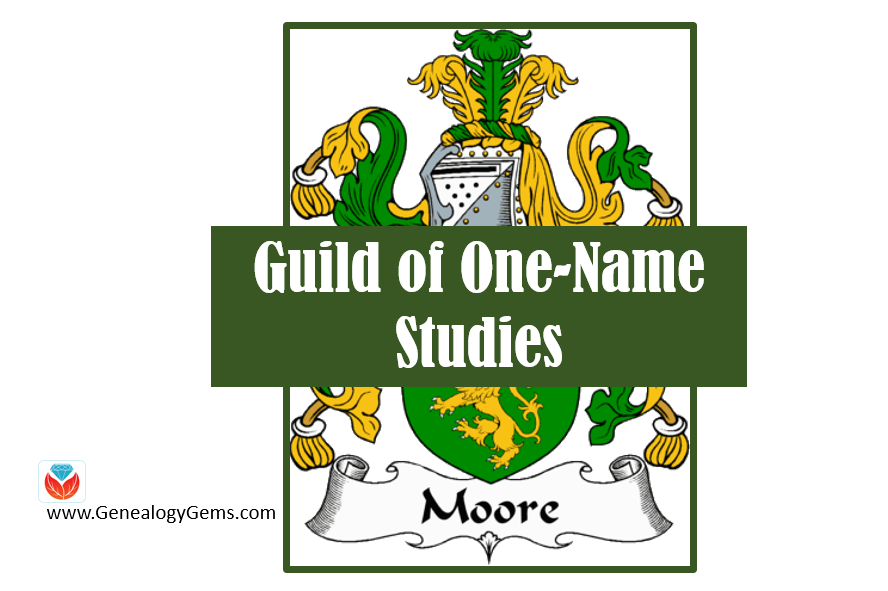
There’s a valuable free but much-overlooked online collection for surname research at FamilySearch.org. These are the family trees of nearly 3000 members of the Guild of One-Name Studies, who are studying nearly 9,000 different surnames. Their resources are strongest for the United Kingdom, where the Guild was founded, but you’ll find members all over the world.
What makes these family trees unique?
There are a couple of things that make these family trees unique:
1. These trees don’t just focus on a mostly-vertical line of ancestors for a single person. Members of the Guild collect everything they can about a particular surname and all its variants (hence the name of the organization). These efforts help organize and connect people with the same surname. Sometimes they help trace the origin of a surname. They can help people explore the variety of spellings and locations associated with different names.
2. These trees are often more fully researched and cited than your average online tree. The Guild takes pride in supporting its members in doing accurate, cited research; keeping their online databases updated; and responding to questions from others about their surname research.
Of course, always use caution when consulting others’ trees. Consider their content to be hints or suggestions until you prove them otherwise yourself. Scrutinize the sources they cite, many of which, say the Guild, aren’t available online elsewhere.
Explore the Guild Surname Research Collections
To explore this helpful free resource, follow the step-by-step instructions below:
1. Go to FamilySearch.org and click Search, then click Genealogies— not Records. (You may also click here to reach that landing page directly.)
2. Enter the surname of interest.
3. Click where it says All next to the Search button.
4. Select Guild of One-Name Studies.
5. Run the search. Click on search results to see:

A. The individual’s name, personal details and (scroll down) associated sources and citation details.
B. The individual’s place in a Guild family tree. Explore this family tree by clicking on someone’s name and seeing their information pop up to the left, where you can also click “View Tree” to see that person’s relatives.
C. Search for names within this tree.
D. This shows you what surname study the information comes from. In this case, you’re also given a link to a separate, associated website for that study.
6. Repeat to learn more about other surnames in your family.
More on Surname Research
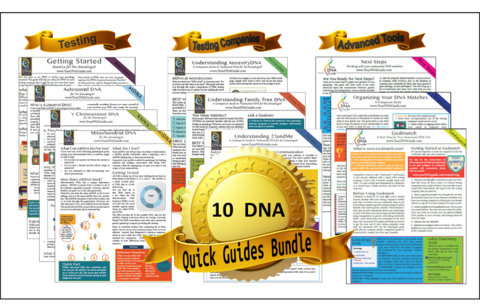 If you are interested in learning even more about surnames research, read Social Network Your yDNA with Surname Projects by our own Diahan Southard, and learn how surname study organizations are taking their research into the 21st century with DNA surname projects.
If you are interested in learning even more about surnames research, read Social Network Your yDNA with Surname Projects by our own Diahan Southard, and learn how surname study organizations are taking their research into the 21st century with DNA surname projects.
Also, learn more about utilizing DNA in your genealogy research with these 10 DNA quick guides from Your DNA Guide, Diahan Southard. They can be purchased in a bundle in either print or digital format.
Genealogy Websites: #1 – 4 of our 25 Websites for Genealogy!
VIDEO & SHOW NOTES: In this video, my guest presenter Gena Philibert-Ortega covers 4 of the biggest genealogy websites that are must-have for family history research. This is a great chance for you to discover some new online tools as well as refresh your memory about terrific sites that may have fallen off your radar. This video is part of a 5 part series totaling 25 essential websites for genealogy.
Websites 1 through 4 of Gena’s 25 Websites for Genealogy
I’m Gina Philibert Ortega, and welcome to 25 Websites for Genealogy, What I’d like to do is talk to you about websites that are must-haves for your genealogical research.
Some of these websites will be new to you, and others are going to be very familiar to you. In talking about the familiar websites, I want to get you thinking about them differently, explain a little bit more about what you can do at these websites, and how to get the most out of them.
In this series of 25 Websites for Genealogy, we’re going to be looking at websites in different categories. Our first category is the big genealogy websites (#1 through 4). So let’s go ahead and get started!
Download the ad-free Show Notes cheat sheet for this video here. (Premium Membership required.)
Websites #1: FamilySearch
The number one website for me is always Family Search. Why is it number one? Well, first of all, Family Search is free. And it’s always nice to find free stuff, right? We want to exhaust what’s free, and what’s available, before we spend money or travel or do anything like that. So for me, the first place you should always go is Family Search.
Learn more: Deep Dive FamilySearch Wiki!
Website #2: Ancestry
as of the time of this video, Ancestry had 33,000 databases that can help you in your genealogy research! Remember to move beyond the search engine and dig into that Card Catalogue to find all the available gems.
Learn more about using Ancestry effectively with our videos:
Website #3: Findmypast
Even though Findmypast is based in England and is heavily focused on British research, you don’t have to have British ancestors to find it useful. It has records from the United States and other countries as well. If you haven’t been using Findmypast, I suggest you go on the website and sign up for a free account. This will allow you to see what they have. You can also go to a FamilySearch center near you and possibly use it for free as many of these genealogy websites have library editions.
You may remember that find Findmypast has PERSI, the periodical source index. Although no longer have PERSI, you can find it at the Allen County Public Library’s Genealogy Center website. Check out our videos below to learn more about using PERSI at the Genealogy Center, and a terrific photo collection at Findmypast.
Learn more about using Findmypast effectively with our videos:
#4: MyHeritage
Like Ancestry and Findmypast, MyHeritage also provides a platform for building your family tree, and has a card catalog called the Collection Catalog featuring over 7000 collections. You can even order a DNA test or upload results from other companies. Use the filters to filter collection, and then by location.
Learn more with our video about 10 of the best features at MyHeritage:
MyHeritage 10 “Don’t Miss” Features You Need
Resources:
Download the ad-free Show Notes cheat sheet for this video here. (Premium Membership required.)
Not a Premium Member yet? Discover the benefits and join today.
